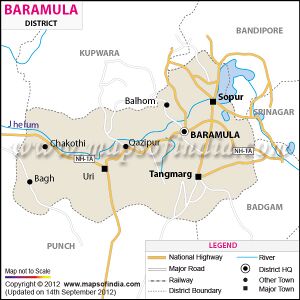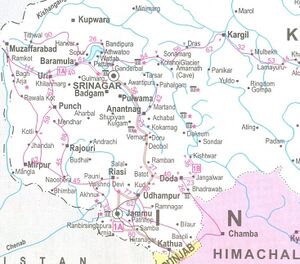Sopore
Sopore (सोपोर) is a village in District Baramulla of Jammu and Kashmir.
Variants of name

Origin of name
- Village gets name after Sura, the minister of Avanti Varmma (853-888 A.D.). [1][2]
- Village gets name after Suyya of Utpal clan in 9th century. It was also known as Suyyapur in ancient times. [3]
History
Avantiverman (853-888 A.D.) belonged to Utpala dynasty emerged as a powerful King of Kashmir who founded Avantipur after his name. His Minister Suyya was a great genius. Suyya who was a great engineer is said to have drained a large chunk of wasteland during his regime. His memory is commemorated by Suyyapur or Sopore, a township in Baramulla district. [4]
In Rajatarangini
Rajatarangini[5]tells that The king, now that the enemies were a little checked, became inflated. Sussala now appeared towards Shurapura. He was the younger brother of Uchchala, and had lived at Avanāha, where he was roused from his lethargy by his father's rebuke and order to join his elder brother. The king of Kalpa assisted him with a few horsemen, and it was long before he could part from his benefactor, and hence his delay. The brothers, who had hitherto manifested a bitter hostility to the enemy, now employed milder means in order to deceive the
[p.273]:enemy. Sussala gained a victory over the king's commander Manikya, and won not only reputation, but wealth also from the battle-field of Shurapura. Thus the opening of his career was brilliant. The king disregarded Uchchala and sent the Lord of Mandala, Patta and others, to fight with Sussala, who was rapidly advancing. Susaala broke the army at Shurapura, and many of the king's soldiers were drowned and perished in the water of the Vaitarani. In this battle the rebellious and powerful Darshanapala was defeated. The survivors of the king's broken army fled on the next day to Sahela, who lived at Dokapunya. Sahela fearing an attack from Sussala, took shelter with the remnant of that broken army within the city. Thus the king was brought to straits by Sussala. His brother Uchchala, who was at Taramula, gained ascendance.
Kasmir visit of Xuanzang in 631 AD
Alexander Cunningham[6] writes that Surapura, the modern Supur or Sopur, is situated on both banks of the Behat River, immediately to the west of the Great Wular Lake. It was originally called Kumbuva, and under this name it is mentioned in the chronicles of Kashmir as early as the beginning of the fifth century.[7] It was rebuilt by Sura, the minister of Avanti Varmma, between A.D. 854 and 883, after whom it was called Surapura. From its favourable position at the outlet of the Wular Lake, I think it probable that it is one of the oldest places in Kashmir.
In Rajatarangini
Rajatarangini[8] tells us [p.107]: The brother and brother's son of Avantivarmma rose against him several times, but he defeated them in battle, and having restored peace in his kingdom, he divided bis wealth among his friends and servants, out of affection towards them. Out of his affection too for his step-brother Suravarmma he raised him to the dignity of heir-apparent. This Suravarmma bestowed the villages of Khadhuya and Hastikarna to Brahmanas, and set up images of two gods named" Suravarmmasvami and Gokula. The holy king also set up a Matha, the pride of the world, and bestowed the village of Panchahasta on Brahmanas. Another brother of the king named Samara, set up images of Rama and his brothers as well as one of Samarasvami. The two younger brothers of Sura named Dhira and Vitrapa who were accountants, built up two temples named after them. These two brothers went up bodily to Kailasa, the heaven of Shiva ! Sura had a door-keeper
[p.108]: named Mahodaya who set up a god named Mahodaya soami. It was in this temple that Rāmaja whose school of grammar was then celebrated, was employed as expositor. Prabhakaravarmma, the king's minister, built a temple of Vishnu named Prabhakarasvami. He had a tame shuka bird who accompanied other Shukas and brought many pearls ; whereupon the minister built the celebrated Shukavali.
The minister Shura patronized learning and encouraged the learned, and many learned men were brought to the court in royal carriages drawn by pair, and were well received. The following authors flourished in this reign :Muktākann, Shivasvami, A'nandavardhana and Ratnākara. Kritamandāra the bard of the minister Shura used to repeat the following sloka in the court as a hint to his master. " This is the time to do good, while fortune lasts, for fortune is naturally fleeting, and danger is always at hand, and when danger comes, there will be no more opportunity to do good." Shura raised many edifices, and among others one for Hara- Parvati, a figure half male and half female, at the shrine Sureshvari. This temple was very strongly built. And having set up the god Shureshvara, he built the temple Shura-matha, as high as his own mansion, for the dwelling of devotees. He built a beautiful town named Shurapura and brought there the celebrated drum which was is Kramavartia. Ratnavardhnna, his son, set up an image
[p.109]: of Shiva named Bhuteshvara at Sureshvari, and built a matha within the enclosure of Shuramatha. Kavyadevi, his wife, set up a Shiva named Kavyadevishvara at Sureshvari.
The king who had no vanity in him, allowed his brothers and Shura and Sura's sons to bear the royal arms. The king was from his childhood a Vishnuvite, but out of regard for Shura he inclined towards Shivaism. He built the town of Avantipura at Vishvoukasara the shrine ,where the souls of the dead receive salvation. There, before he became king, he had set up the image of the god Avantisvami, and after becoming king he set up that of Avantishvara. And out of his silver bathing vessel he made three seats for three gods, Tripureshvara, Bhutesha, and Vijayesha.
Rajatarangini[9] tells ....After fighting several battles in which many were killed, the king attacked Lahara with a large army. At the time of crossing the Sindhu, there being no bridge over it, and the leather bags having burst, Kandaraja and others fell into the water and went to the house of Yama. Driven by the king, Mallakoshta went to Darat and Chhāḍḍa with her son ascended Lahara. Jayyaka, the Lavanya, brought Janaka, Shrivaka and others from Vishalata to the king. The king spent the summer in Lahara and on the approach of autumn went with Yashoraja to Shamala. Ḍambha of royal blood, son of Sajja, was defending Munimusha, when his soldiers fled in fear of Prithvihara, and he fell fighting. In many battles which were fought in the village of Suvarnasanu, at Shurapura and in other places, the king was victorious and successively beat the enemy. (VIII,p.96)
Rajatarangini[10] tells us ...At this time, in the mouth of Shravana, the grateful king went to Vijayeshvara to welcome the victorious lord of Kampana. In the meantime Utpala who was coming from Pinchadeva at Shurapura was murdered by the lord of Dranga in a mountain cavern. He was returning from Pushpananada in order to serve Pinchadeva, when he was found out by the lord of Dranga who was secretly looking out for him. But the lord of Dranga was thrown on the ground and was on the point of death. His knee was pierced with arrow. He killed a soldier of the enemy's party whom he found by him.
The king, after he had bestowed favors on the lord of Kampana, was on his return. He stopped at the gate of Avantipura when Sura of Dranga bowed to him. He was the scourge of his enemy, — he assuaged the anger and the grief of the king. In his first expedition he destroyed his enemies, and the people thought that he had exterminated his foes. When he entered the city, some of the guilty men fled, and Janakasimha and some others were thrown into prison. Koshteshvara and others became his Sura's enemies, through fear of the king. In the month of Karttika, the accomplished king went to Shamala, and there by fierce fighting, he harassed the unfriendly villages. The village of Hāḍi, where the power of king Sussala and others had been broken, was burnt by the powerful Sujji. [VIII (i),p.136]
सोपोर
सोपोर (Sopore) अथवा सोपुर भारत के जम्मू और कश्मीर राज्य के बारामूला ज़िले में स्थित एक नगर और तहसील है। सोपोर टाउन में एशिया की दूसरी सबसे बड़ी फल मंडी (थोक बाजार) है। इसे कश्मीर का एप्पल टाउन भी कहा जाता है। फल मंडी के अलावा, सोपोर एशिया की सबसे बड़ी मीठे पानी की झीलों में से एक, वूलर झील के पास है।
नामोत्पत्ति: सोपोर का मूल नाम "सुय्यापुर" था। यह सुय्या के नाम पर रखा गया था जो राजा अवंतिवर्मन (880 ईसवी) के काल में मंत्रि थे और सोपोर के निर्माण व जल-व्यवस्था में उनका बड़ा हाथ था।[11]
Villages in Sopore Tahsil
Town: 1 Sopore,
Villages 1 Adi Pora, 2 Bohri Pora, 3 Botingu, 4 Brat, 5 Bulagam, 6 Bumai, 7 Chak Haigam, 8 Chera Har, 9 Chhuru, 10 Danger Pora, 11 Dara Nambal, 12 Doru, 13 Gori Pora Dara Pora , 14 Gund Bakir, 15 Gund Brat, 16 Haigam, 17 Hardushuo, 18 Harwan, 19 Hasmat Pora, 20 Idi Pora, 21 Janwara, 22 Krank Shivan, 23 Lalad, 24 Lathi Shath, 25 Logri Pora, 26 Magri Pora, 27 Mala Mapan Pora, 28 Mala Pora Panditan, 29 Mandji, 30 Maz Bug, 31 Muqam Shaheed Mir, 32 Nathi Pora, 33 Nawpora Tujar, 34 Panji Pora, 35 Path Bug, 36 Pathu Kah Muqam, 37 Rakh Haigam , 38 Rampora Rajpur, 39 Rashid Aabad, 40 Renji, 41 Sagi Pora, 42 Said Pora, 43 Sangrama, 44 Seelo , 45 Seer Jagir, 46 Sem Pora, 47 Takia Khan Mohammad, 48 Tarazuea, 49 Tramba Gund, 50 Tujar Pahle Har, 51 Wadura, 52 Wagul, 53 Wara Pora, 54 Watlab, 55 Yamberzal Wari, 56 Zalura , 57 Zooni Pora,
Source - https://www.census2011.co.in/data/subdistrict/32-sopore-baramula-jammu-and-kashmir.html
Jat Gotras
Jat History
- Jagvir Singh Tetarwal (Hawaldar) (1976-2014) (हवलदार जगवीरसिंह तेतरवाल), martyr of Counter Insurgency in Jammu and Kashmir, died on 12 August 2014 in a search operation at Kandmal in Sopore area of Jammu and Kashmir. He belonged to village Jhatawa Khurd of Jhunjhunu tahsil in Jhunjhunu district of Rajasthan.
Notable persons
External Links
References
- ↑ Rajatarangini of Kalhana:Kings of Kashmira/Book V,pp. 108
- ↑ Alexander Cunningham: The Ancient Geography of India/Kingdom of Kashmir,p.99
- ↑ Jyoteeshwar Pathik:Glimpses of History of Jammu & Kashmir, 1997, Anmol Publications Pvt. Limited.
- ↑ Jyoteeshwar Pathik:Glimpses of History of Jammu & Kashmir, 1997, Anmol Publications Pvt. Limited.
- ↑ Rajatarangini of Kalhana:Kings of Kashmira/Book VII (i),pp.260-261
- ↑ The Ancient Geography of India/Kingdom of Kashmir,p.99
- ↑ Ibid., iii. 227.
- ↑ Rajatarangini of Kalhana:Kings of Kashmira/Book V,pp. 107-109
- ↑ Kings of Kashmira Vol 2 (Rajatarangini of Kalhana)/Book VIII,p.96
- ↑ Kings of Kashmira Vol 2 (Rajatarangini of Kalhana)/Book VIII (i) ,p.136
- ↑ Raina, Mohini Qasba (2013). Kashur The Kashmiri Speaking People: Analytical Perspective. Partridge Publishing Singapore. p. 9. ISBN 978-1482-899-47-4.

